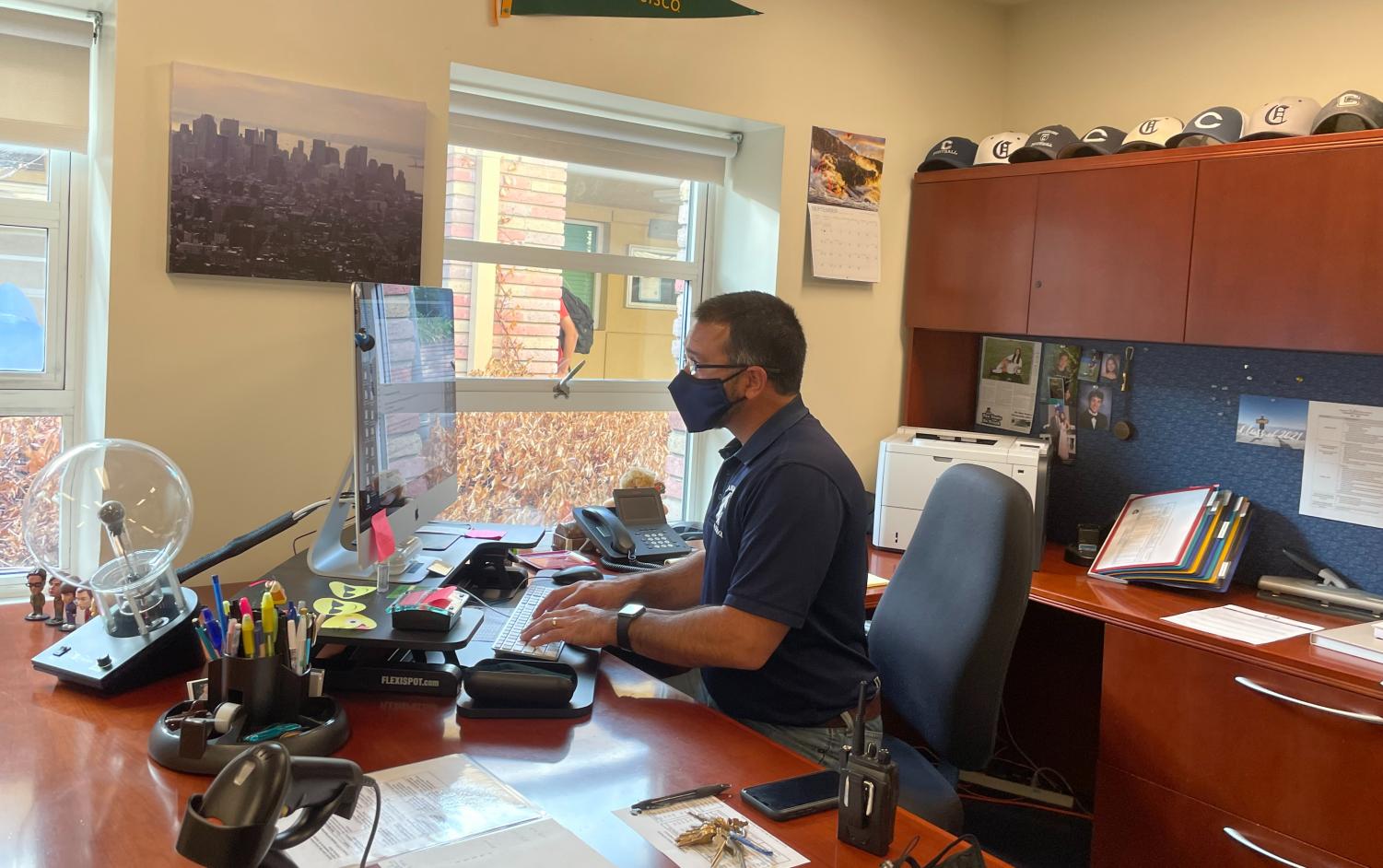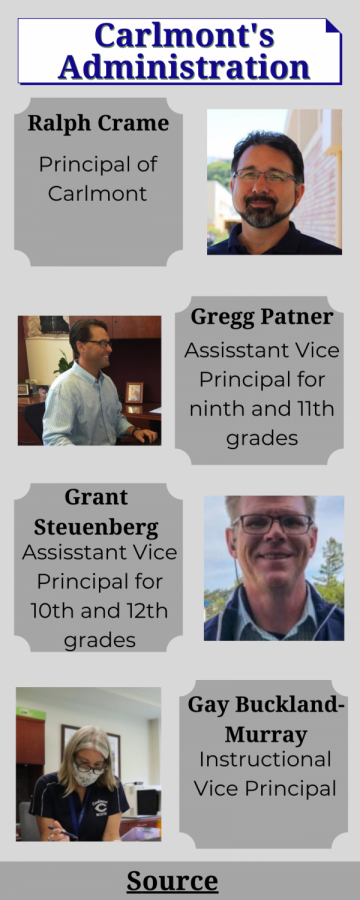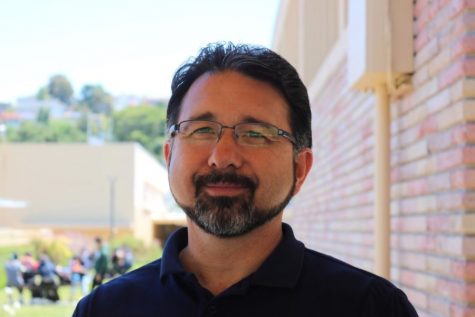
Twitter: @catherine_eik

Twitter username: @LopshireLucy


November 2, 2021
According to Ralph Crame, the principal at Carlmont High School, there are around 2,600 students on campus.
To make the school a safe environment, the administrators must accommodate every student’s needs and well-being. The protection of students formulates every decision made and the consequences of those decisions, making the job of the administration challenging.
The pressures of running a school can be timely, and its demand is unknown to the public eye. One day there might be a need for a behavior policy to handle a student’s behavioral patterns or an academic integrity policy to address cheating issues. Whatever it may be, the creation of the procedures is for the use and protection of Carlmont’s population.
Students see the handbook and policies of Carlmont and often are oblivious to how and why the policies creation took place. The school’s website lists several policies, ideas, and statements, including its mission statement and academic integrity policy.
These policies intend to provide a safe environment for students to grow in and learn. However, not all exhibit it, as issues have arisen since some do not produce that safe feeling.
The Dress Code is one example of a policy written with safety in mind, as its roots at Carlmont date back to gang violence within the community.
“Years ago, the colors you wore were a concern, like [because of] gang activity. For some schools, we don’t have to worry about that now, but there are schools still around the nation that have to worry about that type of safety for students, so limiting what students wear is mainly a safety concern, and that’s why dress code policies were originally enforced,” Ralph Crame, Carlmont’s principal, said.
Along with several other administrators, Crame reiterated that the dress code has changed as Carlmont has grown, with issues like gang violence becoming less of a problem at the school. Often the policy’s language is changed as well, but the general guidelines are not.
Carlmont’s mission statement is another carefully drafted example of the administration working to assist those at school. It states that the school works to create an environment for students to achieve success in the future and applies to the everyday jobs of the administration.
“It’s embedded in all that I do; when I’m working with a student individually, I might be asking them questions if they get in trouble for something. It’s not necessarily just completely punitive; it might be trying to understand the what, the why, the how,” Gregg Patner, an Assistant Vice-Principal (AVP) at Carlmont, said. “And if their reason for doing something is connected to them not being able to grow into who they want to be, then I try to help guide them down that path. I try to incorporate it into my day to day in a lot of different ways.”
Every member of the administration considers how the creation of policies will affect the functions of the school and the atmosphere created for students. Each one is a collaboration within the school leaders in which they formulate the best option for students and proceed from there, resulting in what the students see daily.
While trying to schedule interviews with the administrators, there were several conflicts, such as an unplanned Zoom meeting and constant meetings with staff, students, and parents. Their busy schedules make their jobs packed and stressful, with a continuous goal of pleasing as many people as possible. That goal is challenging to accomplish since Carlmont has over 2,000 students and makes decisions difficult.

In regards to the dress code, Grant Steunenberg, the AVP for 10th and 12th graders at Carlmont High School, said, “That’s where our job becomes very challenging and difficult is that we become the judge and jury of what is appropriate and what’s inappropriate. There are always students who disagree with our judgment of what is appropriate or inappropriate. That’s a very challenging part of our job because we oftentimes make people upset with us in regards to how we deem things to be appropriate or inappropriate, but at the end of the day, [the] Education Code supports us in being able to make those judgments.”
The controversy regarding the dress code is amongst many that the administration deals with annually. Part of their job includes fielding teacher and administration issues and decisions, but it depends on which administrator handles the situation.
“If it’s about a parent who is upset with a coach, and they want the coach fired, and what kind of a decision are we going to make about how we address the coach, I’m going to collaborate with my administrative team as well as my athletic director,” Stuenenberg said.
Collaborating remains an essential part of their jobs, as they created the policies and rules enforced every day on campus, which sometimes leaves questions of why. The tracing of these questions can be back to the primary purpose of the administration; student safety and a healthy environment.
Crame went into detail about the reason behind everything the administration does.
He said, “We have a set of rules that we have to follow, right. There’s law, there’s ed code, and then there’s safety that we have to keep in mind. Some of the policies we have in place are there for the safety of students, not just physical safety, but emotional safety of students as well. If there’s ever a question about any of our policies, if there’s any question about how we operate, we welcome that conversation from students because it affects you the most.”
He also explained the possible results of conversations between students and staff, which he encourages.
“Whatever people have perceived about how we operate, we want to make sure they understand it is an open dialogue and if they need more information about something that we have an open-door policy, [and they can] come talk to us,” Crame said. “I can’t guarantee you that there’s going to be a change, but I can say we’ll have a discussion and hopefully a better understanding of why a policy is in place.”
The administration’s open-door policy and willingness to collaborate with individuals work towards their eventual goal of what is best for students and how its achievement is possible.
The policies instituted at Carlmont are just the tip of the iceberg of how administrators run the operations. From food distribution measures to emergency meetings requiring attendance, many of these behind-the-scenes events happen daily, without the student body ever knowing of them.

Take risks, and I’m not talking about physical risks putting your life in danger, I’m talking about stepping out of your comfort zone a little bit and taking those chances so that you can grow and learn.
— Ralph Crame
“Just because you don’t see somebody, all the time, or interact with them doesn’t mean they’re not doing something, and that’s pretty common for people to think, you know, out of sight out of mind a little bit,” Patner said. “There’s a lot of work, especially this year… you’re working at a breakneck speed to get caught up and do all the different nuances.”
As this is the first time in a year and a half that students are back on campus completely, it has become an adjustment for administrators and staff to tackle more immediate problems since last school year was a distance-learning environment. Unlike last year, safety needs are more vital than ever.
Adapting to the Centers for Disease Control and Prevention and San Mateo County guidelines, Carlmont has had to continuously update its safety guidelines and policies to make sure the learning environment is safe for all.
The safety needs of Carlmont’s population also include the well-being of all students. Counselors and adult staff members are there to talk with and aid students in need.
“To be safe, physically and emotionally, so the most important one is that you feel safe here, you feel connected, and you feel you have adults you can turn to for advice and support and help,” Crame said.
Another aspect of the different administrator’s duties that might have been unknown to the general student population was that the specific tasks they each have to deal with are not always a part of their regular agendas. Requirements of unexpected behavioral assessments, complaints about a particular issue, or campus check-ins add to an administrator’s plate throughout the day. However, they are all assigned different tasks around campus, excluding emergencies.
Crame oversees facilities and much of the daily operations of staff on campus while also making the final decisions about any lingering conflict. Patner handles issues pertaining to ninth and 11th grades while also overseeing accommodation plans and food services. Stuenenberg has to take care of issues within the 10th and 12th grades and oversees athletics and decision-making by having conversations with others.
With Stuenenberg’s position, as for many of the staff on campus, decision-making for more significant issues or situations is usually circumstantial. This is due to the need for others’ opinions to be collected and taken into consideration.
“[For] all big decisions, we sit down as an admin team and go over them,” Stuenenberg said. “We meet twice a week, and those are the meetings we have, making sure that we’ve considered all the possibilities.”
Students are consumed in their school duties such as homework, team sports, clubs, and more, and might not consider all of the factors that go into running a school and making the experience the same for all. This perception is not the case as many of the staff’s jobs help create a more effective, creative, and friendly school lifestyle.
The administration may receive criticism at times for resolving different school issues. Still, their overall goal is to make this learning environment equal and fair to all and transition students into the real world and prepare them for its hasty demands.
“By the time they walk across the stage, [we hope] that we have not only provided them with an education…but the graduation ceremony is like a symbolic handing off to society where we are saying ‘we are providing you with a group of people who will be productive citizens in society,'” Stuenenberg said.
Everything set in place and handled on campus is done for students’ futures and how they will endure in their adult livelihoods. The meaning of every policy is to keep Carlmont’s population safe. Without these policies, operating a school would likely prove to be impossible.
Remembering that we all make mistakes and that no one is perfect is crucial for students and staff to grasp. The pressures of an administrator’s job may be stressful, but so can a student. That shared stress can help us all become better versions of ourselves and sympathize with each other more to grow our community.
“The stress about being perfect on a campus I don’t think should be there,” Crame said. “I think this is a time when, as young adults, [you] should take risks, and I’m not talking about physical risks putting your life in danger. I’m talking about stepping out of your comfort zone a little bit and taking those chances so that you can grow and learn.”

